Analysis of Pain Management at Mercy Community Residential Aged Care
VerifiedAdded on 2021/06/15
|33
|5374
|14
Report
AI Summary
This report documents and analyzes the current pain management processes at Mercy Community Residential Aged Care Services. It details a project that involved literature review and field-based research, including residents with dementia and cognitive impairments. The research employed quantitative data analysis to evaluate the effectiveness of existing pain management strategies and identify barriers. Key findings emphasize the importance of staff training, implementation of appropriate protocols, and policies to improve healthcare services. The report includes a stakeholder analysis, communication plan, timeline, risk management assessment, and recommendations for enhancing pain management, particularly for residents suffering from dementia, with the ultimate goal of improving the quality of care. The project used survey data from residents and staff, and the report provides valuable insights into the challenges and opportunities in aged care pain management.
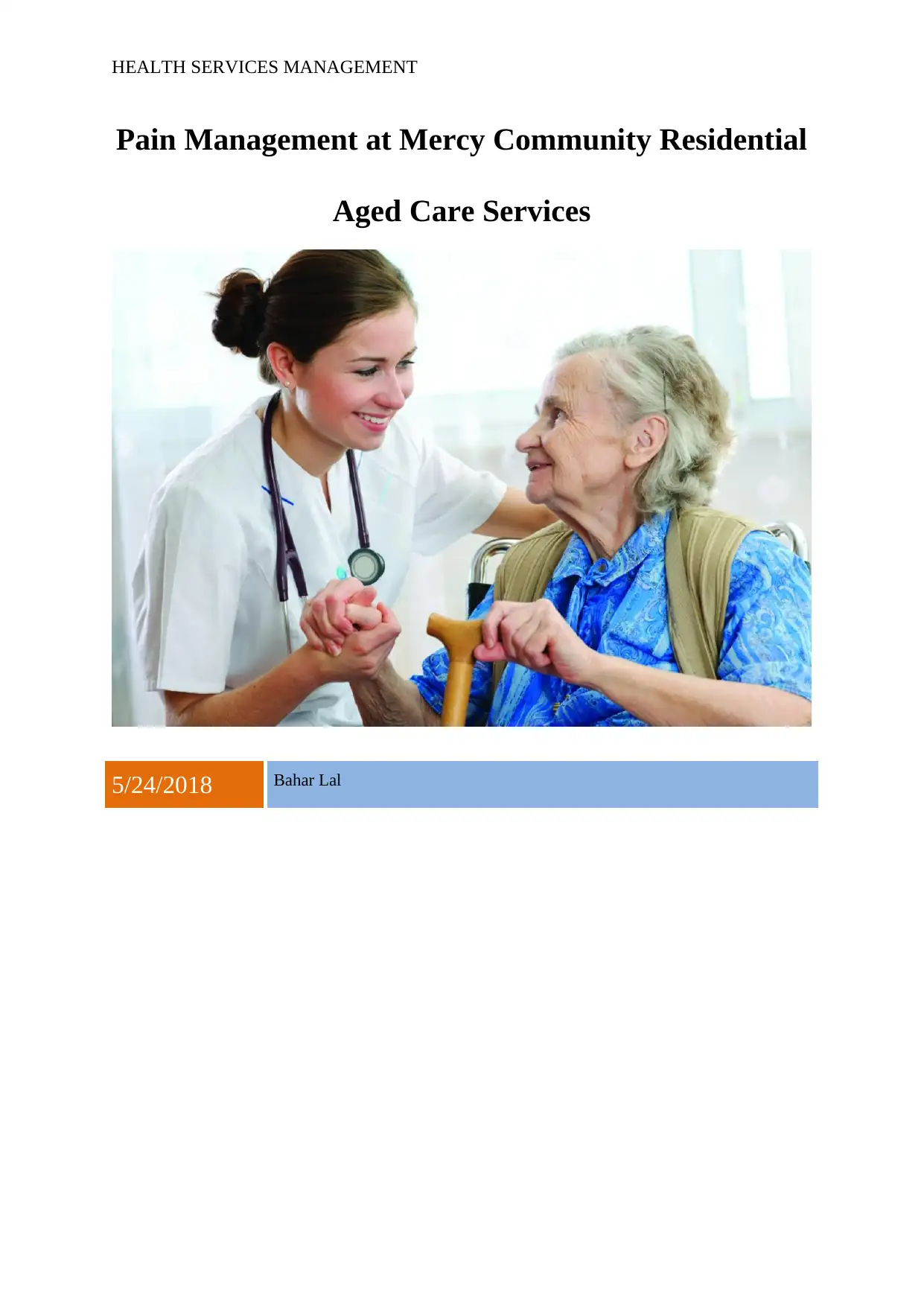
HEALTH SERVICES MANAGEMENT
Pain Management at Mercy Community Residential
Aged Care Services
5/24/2018 Bahar Lal
Pain Management at Mercy Community Residential
Aged Care Services
5/24/2018 Bahar Lal
Paraphrase This Document
Need a fresh take? Get an instant paraphrase of this document with our AI Paraphraser
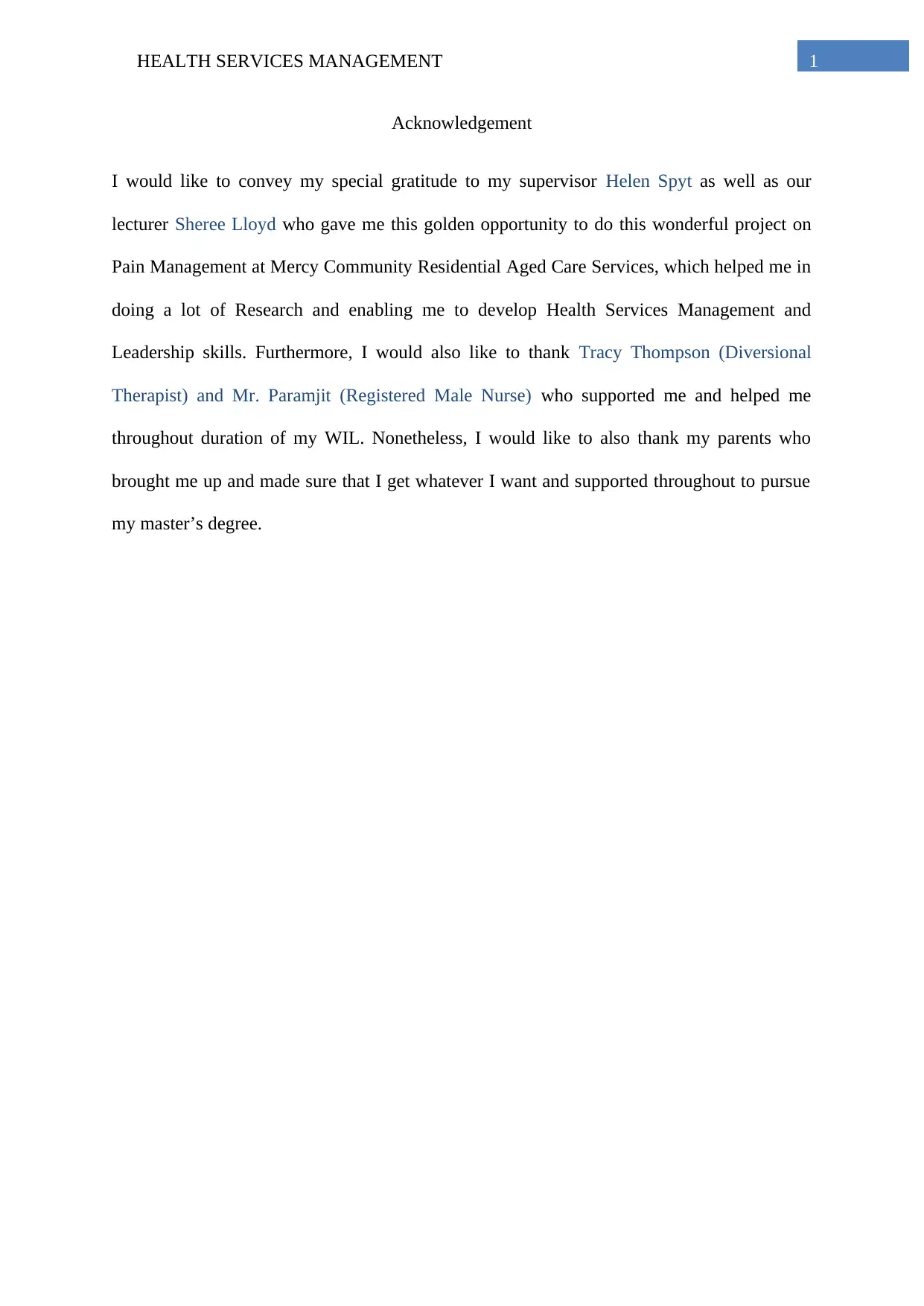
1HEALTH SERVICES MANAGEMENT
Acknowledgement
I would like to convey my special gratitude to my supervisor Helen Spyt as well as our
lecturer Sheree Lloyd who gave me this golden opportunity to do this wonderful project on
Pain Management at Mercy Community Residential Aged Care Services, which helped me in
doing a lot of Research and enabling me to develop Health Services Management and
Leadership skills. Furthermore, I would also like to thank Tracy Thompson (Diversional
Therapist) and Mr. Paramjit (Registered Male Nurse) who supported me and helped me
throughout duration of my WIL. Nonetheless, I would like to also thank my parents who
brought me up and made sure that I get whatever I want and supported throughout to pursue
my master’s degree.
Acknowledgement
I would like to convey my special gratitude to my supervisor Helen Spyt as well as our
lecturer Sheree Lloyd who gave me this golden opportunity to do this wonderful project on
Pain Management at Mercy Community Residential Aged Care Services, which helped me in
doing a lot of Research and enabling me to develop Health Services Management and
Leadership skills. Furthermore, I would also like to thank Tracy Thompson (Diversional
Therapist) and Mr. Paramjit (Registered Male Nurse) who supported me and helped me
throughout duration of my WIL. Nonetheless, I would like to also thank my parents who
brought me up and made sure that I get whatever I want and supported throughout to pursue
my master’s degree.
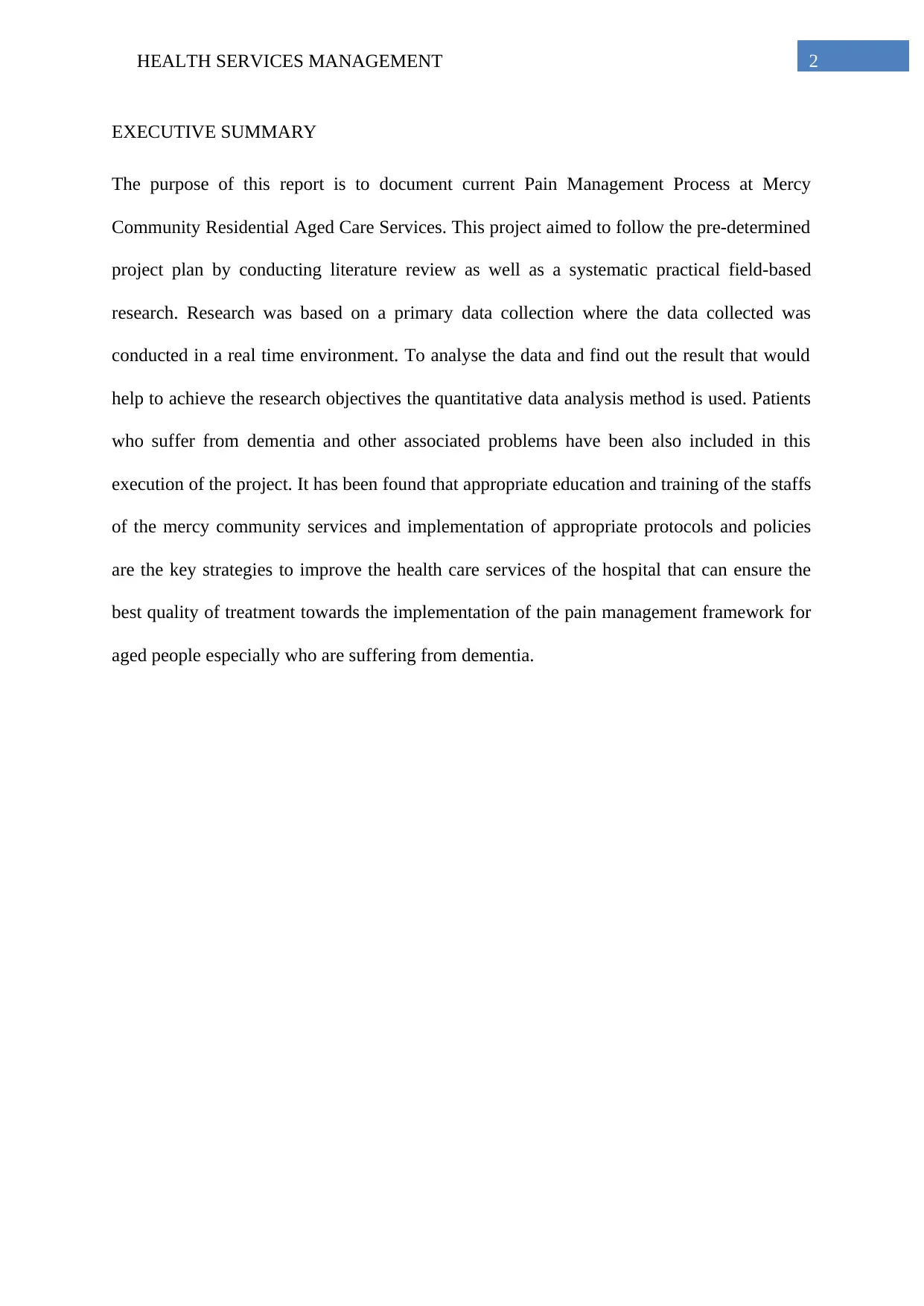
2HEALTH SERVICES MANAGEMENT
EXECUTIVE SUMMARY
The purpose of this report is to document current Pain Management Process at Mercy
Community Residential Aged Care Services. This project aimed to follow the pre-determined
project plan by conducting literature review as well as a systematic practical field-based
research. Research was based on a primary data collection where the data collected was
conducted in a real time environment. To analyse the data and find out the result that would
help to achieve the research objectives the quantitative data analysis method is used. Patients
who suffer from dementia and other associated problems have been also included in this
execution of the project. It has been found that appropriate education and training of the staffs
of the mercy community services and implementation of appropriate protocols and policies
are the key strategies to improve the health care services of the hospital that can ensure the
best quality of treatment towards the implementation of the pain management framework for
aged people especially who are suffering from dementia.
EXECUTIVE SUMMARY
The purpose of this report is to document current Pain Management Process at Mercy
Community Residential Aged Care Services. This project aimed to follow the pre-determined
project plan by conducting literature review as well as a systematic practical field-based
research. Research was based on a primary data collection where the data collected was
conducted in a real time environment. To analyse the data and find out the result that would
help to achieve the research objectives the quantitative data analysis method is used. Patients
who suffer from dementia and other associated problems have been also included in this
execution of the project. It has been found that appropriate education and training of the staffs
of the mercy community services and implementation of appropriate protocols and policies
are the key strategies to improve the health care services of the hospital that can ensure the
best quality of treatment towards the implementation of the pain management framework for
aged people especially who are suffering from dementia.
⊘ This is a preview!⊘
Do you want full access?
Subscribe today to unlock all pages.

Trusted by 1+ million students worldwide
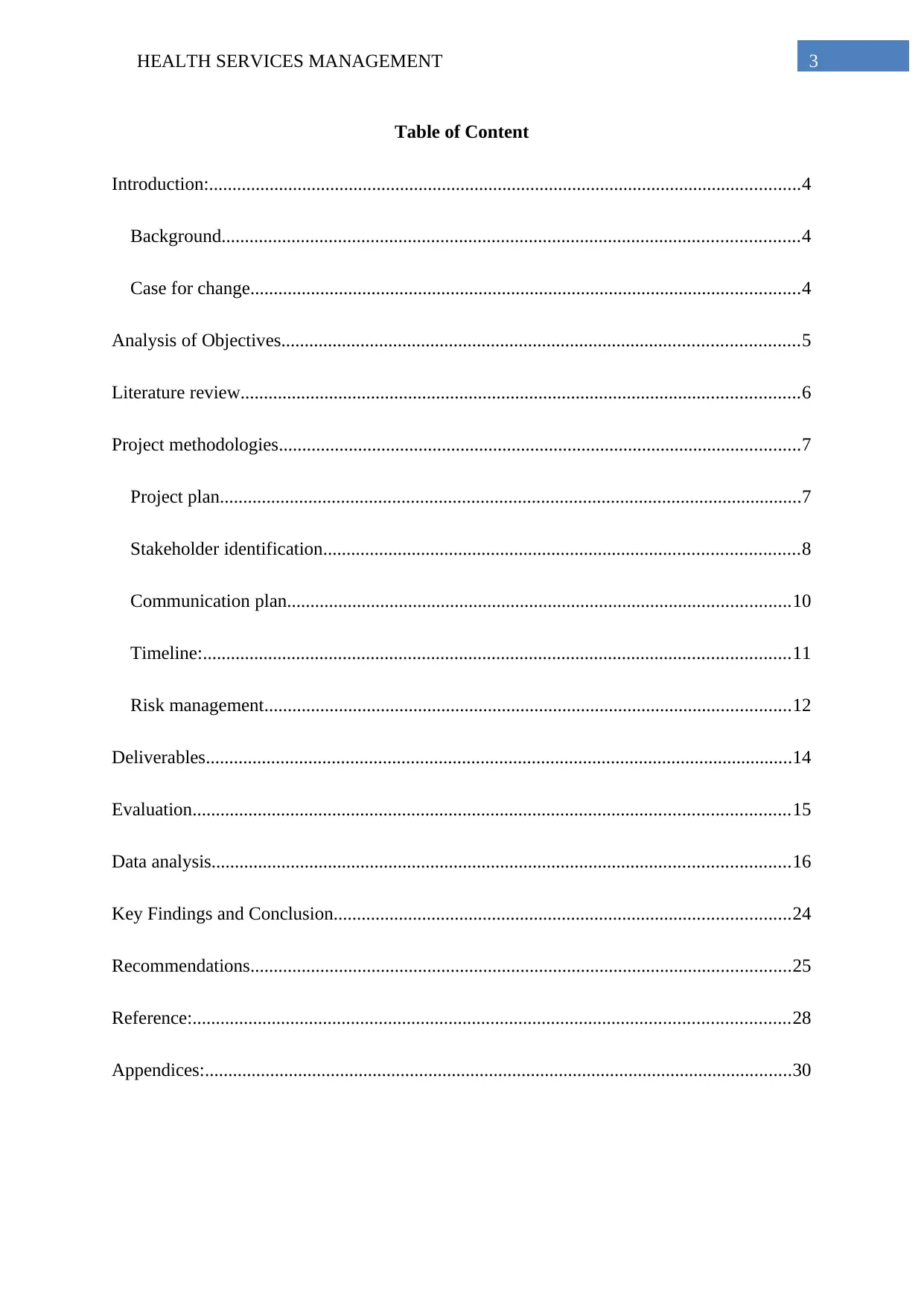
3HEALTH SERVICES MANAGEMENT
Table of Content
Introduction:...............................................................................................................................4
Background............................................................................................................................4
Case for change......................................................................................................................4
Analysis of Objectives...............................................................................................................5
Literature review........................................................................................................................6
Project methodologies................................................................................................................7
Project plan.............................................................................................................................7
Stakeholder identification......................................................................................................8
Communication plan............................................................................................................10
Timeline:..............................................................................................................................11
Risk management.................................................................................................................12
Deliverables..............................................................................................................................14
Evaluation................................................................................................................................15
Data analysis............................................................................................................................16
Key Findings and Conclusion..................................................................................................24
Recommendations....................................................................................................................25
Reference:................................................................................................................................28
Appendices:..............................................................................................................................30
Table of Content
Introduction:...............................................................................................................................4
Background............................................................................................................................4
Case for change......................................................................................................................4
Analysis of Objectives...............................................................................................................5
Literature review........................................................................................................................6
Project methodologies................................................................................................................7
Project plan.............................................................................................................................7
Stakeholder identification......................................................................................................8
Communication plan............................................................................................................10
Timeline:..............................................................................................................................11
Risk management.................................................................................................................12
Deliverables..............................................................................................................................14
Evaluation................................................................................................................................15
Data analysis............................................................................................................................16
Key Findings and Conclusion..................................................................................................24
Recommendations....................................................................................................................25
Reference:................................................................................................................................28
Appendices:..............................................................................................................................30
Paraphrase This Document
Need a fresh take? Get an instant paraphrase of this document with our AI Paraphraser
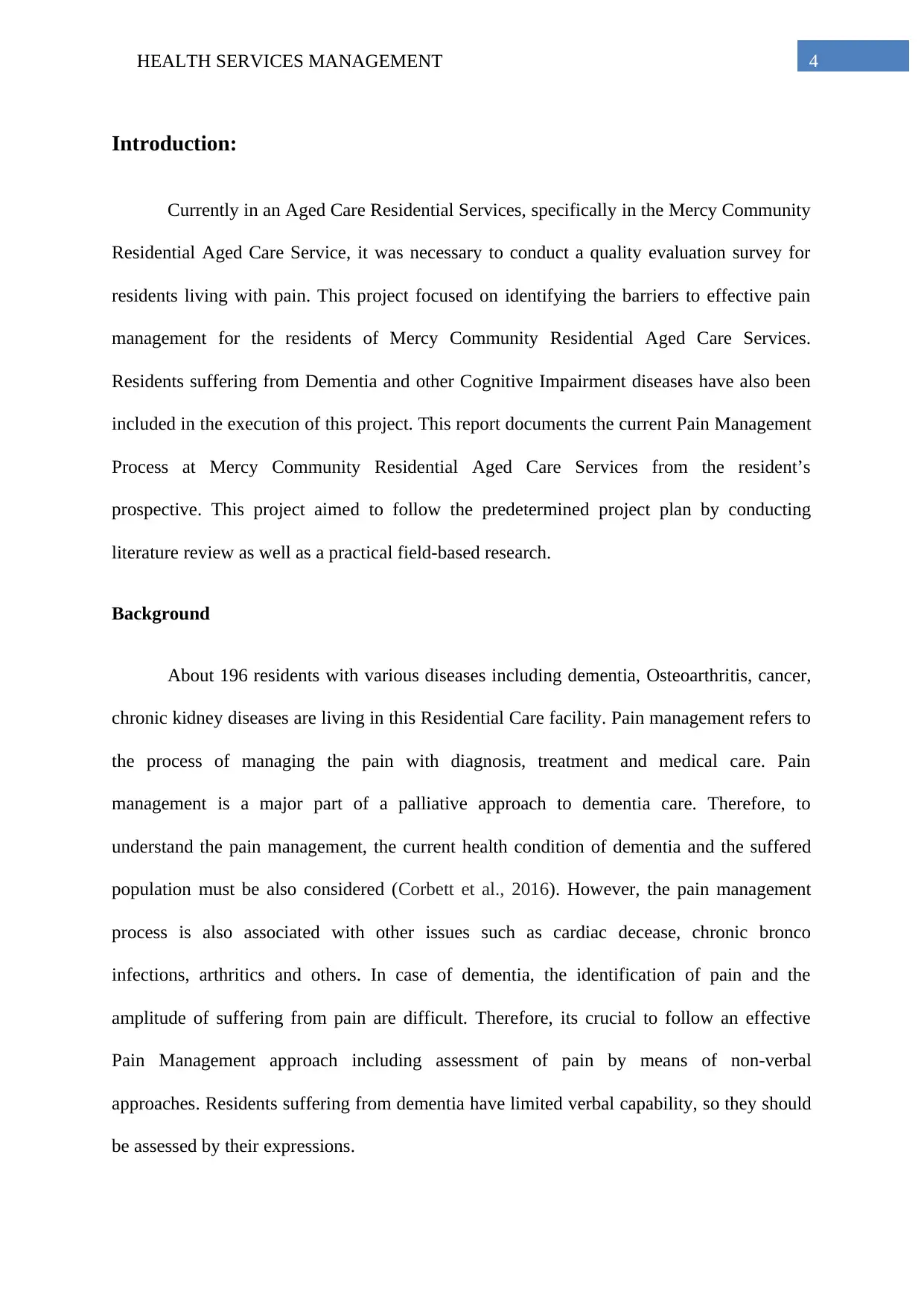
4HEALTH SERVICES MANAGEMENT
Introduction:
Currently in an Aged Care Residential Services, specifically in the Mercy Community
Residential Aged Care Service, it was necessary to conduct a quality evaluation survey for
residents living with pain. This project focused on identifying the barriers to effective pain
management for the residents of Mercy Community Residential Aged Care Services.
Residents suffering from Dementia and other Cognitive Impairment diseases have also been
included in the execution of this project. This report documents the current Pain Management
Process at Mercy Community Residential Aged Care Services from the resident’s
prospective. This project aimed to follow the predetermined project plan by conducting
literature review as well as a practical field-based research.
Background
About 196 residents with various diseases including dementia, Osteoarthritis, cancer,
chronic kidney diseases are living in this Residential Care facility. Pain management refers to
the process of managing the pain with diagnosis, treatment and medical care. Pain
management is a major part of a palliative approach to dementia care. Therefore, to
understand the pain management, the current health condition of dementia and the suffered
population must be also considered (Corbett et al., 2016). However, the pain management
process is also associated with other issues such as cardiac decease, chronic bronco
infections, arthritics and others. In case of dementia, the identification of pain and the
amplitude of suffering from pain are difficult. Therefore, its crucial to follow an effective
Pain Management approach including assessment of pain by means of non-verbal
approaches. Residents suffering from dementia have limited verbal capability, so they should
be assessed by their expressions.
Introduction:
Currently in an Aged Care Residential Services, specifically in the Mercy Community
Residential Aged Care Service, it was necessary to conduct a quality evaluation survey for
residents living with pain. This project focused on identifying the barriers to effective pain
management for the residents of Mercy Community Residential Aged Care Services.
Residents suffering from Dementia and other Cognitive Impairment diseases have also been
included in the execution of this project. This report documents the current Pain Management
Process at Mercy Community Residential Aged Care Services from the resident’s
prospective. This project aimed to follow the predetermined project plan by conducting
literature review as well as a practical field-based research.
Background
About 196 residents with various diseases including dementia, Osteoarthritis, cancer,
chronic kidney diseases are living in this Residential Care facility. Pain management refers to
the process of managing the pain with diagnosis, treatment and medical care. Pain
management is a major part of a palliative approach to dementia care. Therefore, to
understand the pain management, the current health condition of dementia and the suffered
population must be also considered (Corbett et al., 2016). However, the pain management
process is also associated with other issues such as cardiac decease, chronic bronco
infections, arthritics and others. In case of dementia, the identification of pain and the
amplitude of suffering from pain are difficult. Therefore, its crucial to follow an effective
Pain Management approach including assessment of pain by means of non-verbal
approaches. Residents suffering from dementia have limited verbal capability, so they should
be assessed by their expressions.
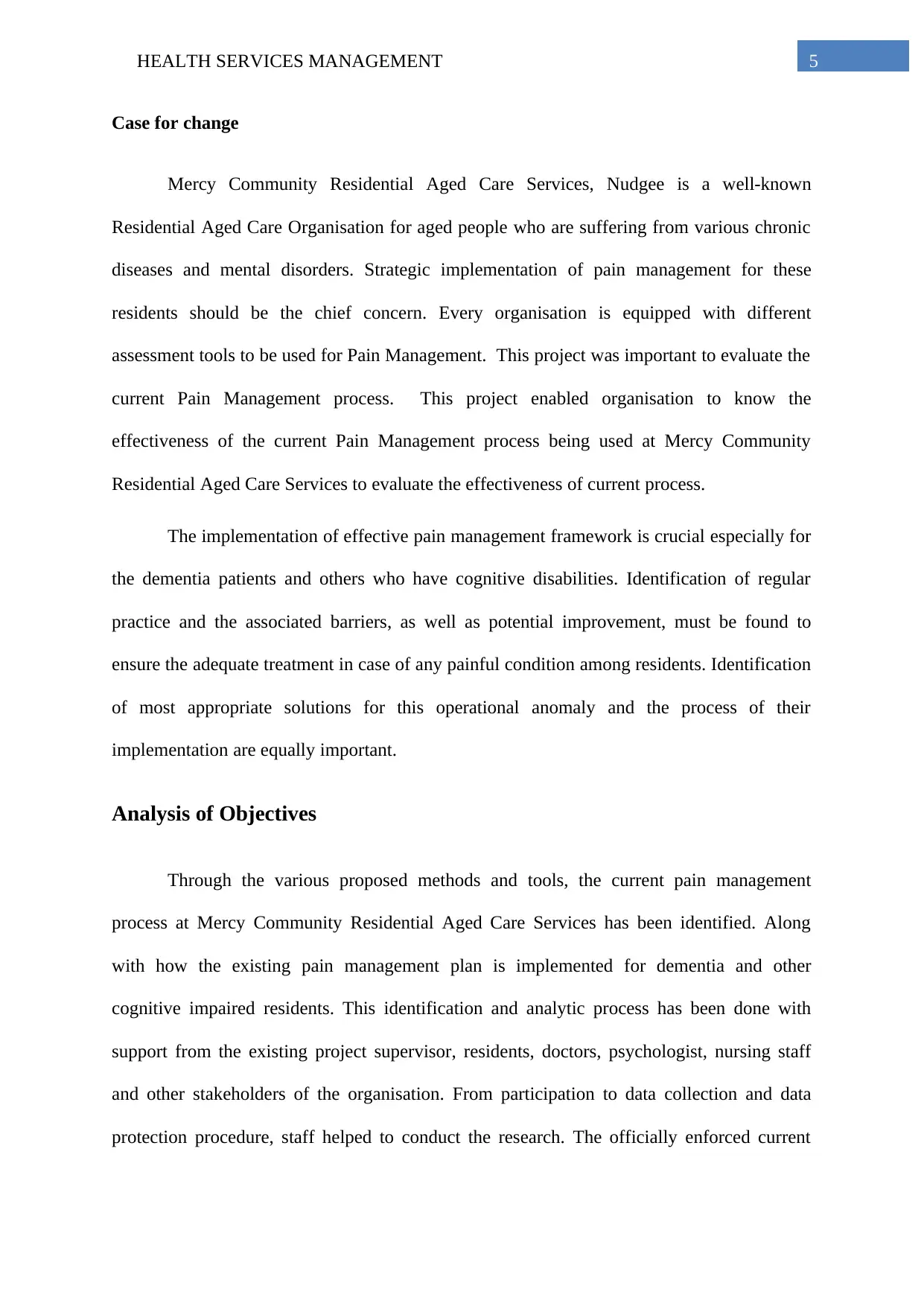
5HEALTH SERVICES MANAGEMENT
Case for change
Mercy Community Residential Aged Care Services, Nudgee is a well-known
Residential Aged Care Organisation for aged people who are suffering from various chronic
diseases and mental disorders. Strategic implementation of pain management for these
residents should be the chief concern. Every organisation is equipped with different
assessment tools to be used for Pain Management. This project was important to evaluate the
current Pain Management process. This project enabled organisation to know the
effectiveness of the current Pain Management process being used at Mercy Community
Residential Aged Care Services to evaluate the effectiveness of current process.
The implementation of effective pain management framework is crucial especially for
the dementia patients and others who have cognitive disabilities. Identification of regular
practice and the associated barriers, as well as potential improvement, must be found to
ensure the adequate treatment in case of any painful condition among residents. Identification
of most appropriate solutions for this operational anomaly and the process of their
implementation are equally important.
Analysis of Objectives
Through the various proposed methods and tools, the current pain management
process at Mercy Community Residential Aged Care Services has been identified. Along
with how the existing pain management plan is implemented for dementia and other
cognitive impaired residents. This identification and analytic process has been done with
support from the existing project supervisor, residents, doctors, psychologist, nursing staff
and other stakeholders of the organisation. From participation to data collection and data
protection procedure, staff helped to conduct the research. The officially enforced current
Case for change
Mercy Community Residential Aged Care Services, Nudgee is a well-known
Residential Aged Care Organisation for aged people who are suffering from various chronic
diseases and mental disorders. Strategic implementation of pain management for these
residents should be the chief concern. Every organisation is equipped with different
assessment tools to be used for Pain Management. This project was important to evaluate the
current Pain Management process. This project enabled organisation to know the
effectiveness of the current Pain Management process being used at Mercy Community
Residential Aged Care Services to evaluate the effectiveness of current process.
The implementation of effective pain management framework is crucial especially for
the dementia patients and others who have cognitive disabilities. Identification of regular
practice and the associated barriers, as well as potential improvement, must be found to
ensure the adequate treatment in case of any painful condition among residents. Identification
of most appropriate solutions for this operational anomaly and the process of their
implementation are equally important.
Analysis of Objectives
Through the various proposed methods and tools, the current pain management
process at Mercy Community Residential Aged Care Services has been identified. Along
with how the existing pain management plan is implemented for dementia and other
cognitive impaired residents. This identification and analytic process has been done with
support from the existing project supervisor, residents, doctors, psychologist, nursing staff
and other stakeholders of the organisation. From participation to data collection and data
protection procedure, staff helped to conduct the research. The officially enforced current
⊘ This is a preview!⊘
Do you want full access?
Subscribe today to unlock all pages.

Trusted by 1+ million students worldwide
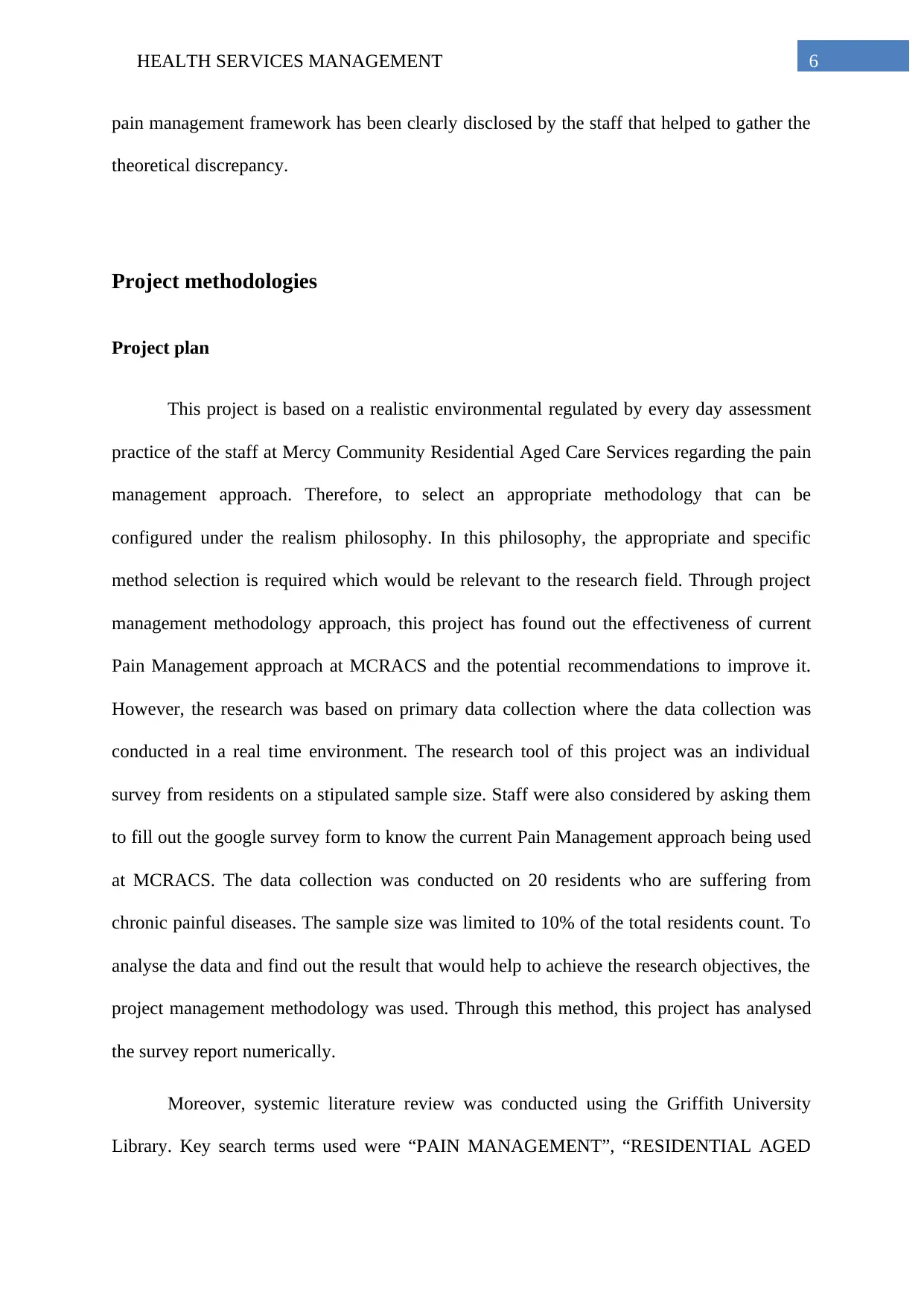
6HEALTH SERVICES MANAGEMENT
pain management framework has been clearly disclosed by the staff that helped to gather the
theoretical discrepancy.
Project methodologies
Project plan
This project is based on a realistic environmental regulated by every day assessment
practice of the staff at Mercy Community Residential Aged Care Services regarding the pain
management approach. Therefore, to select an appropriate methodology that can be
configured under the realism philosophy. In this philosophy, the appropriate and specific
method selection is required which would be relevant to the research field. Through project
management methodology approach, this project has found out the effectiveness of current
Pain Management approach at MCRACS and the potential recommendations to improve it.
However, the research was based on primary data collection where the data collection was
conducted in a real time environment. The research tool of this project was an individual
survey from residents on a stipulated sample size. Staff were also considered by asking them
to fill out the google survey form to know the current Pain Management approach being used
at MCRACS. The data collection was conducted on 20 residents who are suffering from
chronic painful diseases. The sample size was limited to 10% of the total residents count. To
analyse the data and find out the result that would help to achieve the research objectives, the
project management methodology was used. Through this method, this project has analysed
the survey report numerically.
Moreover, systemic literature review was conducted using the Griffith University
Library. Key search terms used were “PAIN MANAGEMENT”, “RESIDENTIAL AGED
pain management framework has been clearly disclosed by the staff that helped to gather the
theoretical discrepancy.
Project methodologies
Project plan
This project is based on a realistic environmental regulated by every day assessment
practice of the staff at Mercy Community Residential Aged Care Services regarding the pain
management approach. Therefore, to select an appropriate methodology that can be
configured under the realism philosophy. In this philosophy, the appropriate and specific
method selection is required which would be relevant to the research field. Through project
management methodology approach, this project has found out the effectiveness of current
Pain Management approach at MCRACS and the potential recommendations to improve it.
However, the research was based on primary data collection where the data collection was
conducted in a real time environment. The research tool of this project was an individual
survey from residents on a stipulated sample size. Staff were also considered by asking them
to fill out the google survey form to know the current Pain Management approach being used
at MCRACS. The data collection was conducted on 20 residents who are suffering from
chronic painful diseases. The sample size was limited to 10% of the total residents count. To
analyse the data and find out the result that would help to achieve the research objectives, the
project management methodology was used. Through this method, this project has analysed
the survey report numerically.
Moreover, systemic literature review was conducted using the Griffith University
Library. Key search terms used were “PAIN MANAGEMENT”, “RESIDENTIAL AGED
Paraphrase This Document
Need a fresh take? Get an instant paraphrase of this document with our AI Paraphraser

7HEALTH SERVICES MANAGEMENT
CARE”, “BARRIERS” and “PAIN ASSESSMENT”. Search was refined to articles published
between 2012 and 2018, journal articles and full text online. Articles published in English
language only were reviewed. Initially about 4300 articles came up as a result. After reading
abstract of all the articles 100 articles seemed suitable for the review. After complete
evaluation of those 100 articles, 25 articles were selected for the literature review to form the
survey questions and provide recommendations along with the survey. The survey was
conducted on the residents of Mercy Community Residential Aged Care Services. Therefore,
ethical consideration of this research project must be the major concern keeping the
venerability of the respondents in mind. In accordance to the data protection act this project
has the commitment that the collected data and information will only be used for research
purposes by prioritising the confidentiality. Similarly, the participation of the residents was
voluntarily. The willingness of the residents was the major concern while ensuring the
research procedure would not cause any harm to the respondents.
Stakeholder identification
Stakeholders are the core responsible people for any project who regulate the
accuracy and effectiveness of the outcomes from the data collection and analysis process. The
sponsors have the major role to support the project and its execution by providing financial
feedback. The supervisor of this project monitored the overall activity and the efficiency of
the research procedure and executions. In evaluation part, supervisors had the most valuable
role to control and regulate the project operations to the most accurate functionality.
Cooperative coordination within the project team is the key to this successful research
project. The nurses and caregivers have been provided adequate information about residential
aged care based organisational operation in existing pain management practice. Along with
the residents, the staff supported the project by informing about the barriers they face in
CARE”, “BARRIERS” and “PAIN ASSESSMENT”. Search was refined to articles published
between 2012 and 2018, journal articles and full text online. Articles published in English
language only were reviewed. Initially about 4300 articles came up as a result. After reading
abstract of all the articles 100 articles seemed suitable for the review. After complete
evaluation of those 100 articles, 25 articles were selected for the literature review to form the
survey questions and provide recommendations along with the survey. The survey was
conducted on the residents of Mercy Community Residential Aged Care Services. Therefore,
ethical consideration of this research project must be the major concern keeping the
venerability of the respondents in mind. In accordance to the data protection act this project
has the commitment that the collected data and information will only be used for research
purposes by prioritising the confidentiality. Similarly, the participation of the residents was
voluntarily. The willingness of the residents was the major concern while ensuring the
research procedure would not cause any harm to the respondents.
Stakeholder identification
Stakeholders are the core responsible people for any project who regulate the
accuracy and effectiveness of the outcomes from the data collection and analysis process. The
sponsors have the major role to support the project and its execution by providing financial
feedback. The supervisor of this project monitored the overall activity and the efficiency of
the research procedure and executions. In evaluation part, supervisors had the most valuable
role to control and regulate the project operations to the most accurate functionality.
Cooperative coordination within the project team is the key to this successful research
project. The nurses and caregivers have been provided adequate information about residential
aged care based organisational operation in existing pain management practice. Along with
the residents, the staff supported the project by informing about the barriers they face in
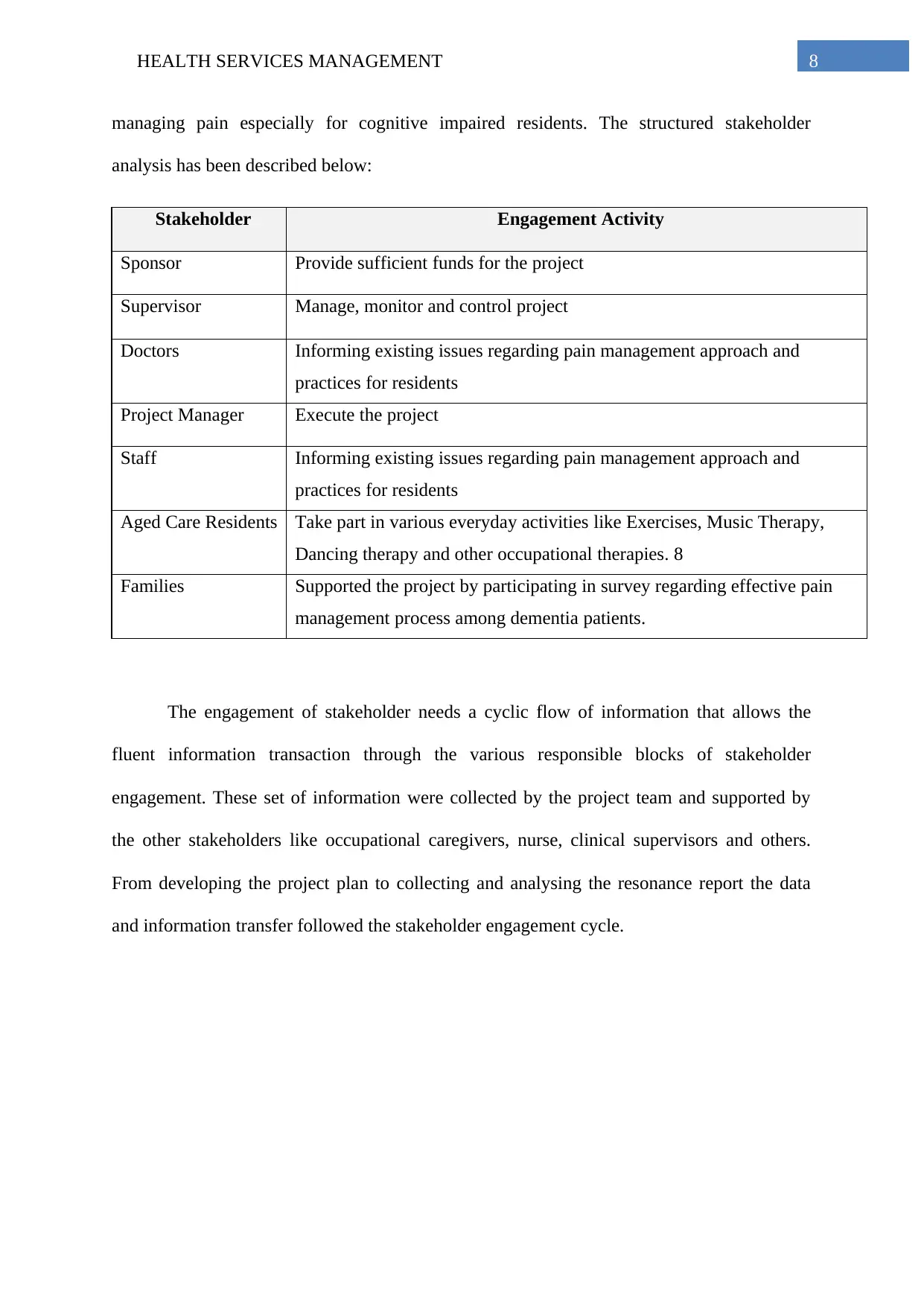
8HEALTH SERVICES MANAGEMENT
managing pain especially for cognitive impaired residents. The structured stakeholder
analysis has been described below:
Stakeholder Engagement Activity
Sponsor Provide sufficient funds for the project
Supervisor Manage, monitor and control project
Doctors Informing existing issues regarding pain management approach and
practices for residents
Project Manager Execute the project
Staff Informing existing issues regarding pain management approach and
practices for residents
Aged Care Residents Take part in various everyday activities like Exercises, Music Therapy,
Dancing therapy and other occupational therapies. 8
Families Supported the project by participating in survey regarding effective pain
management process among dementia patients.
The engagement of stakeholder needs a cyclic flow of information that allows the
fluent information transaction through the various responsible blocks of stakeholder
engagement. These set of information were collected by the project team and supported by
the other stakeholders like occupational caregivers, nurse, clinical supervisors and others.
From developing the project plan to collecting and analysing the resonance report the data
and information transfer followed the stakeholder engagement cycle.
managing pain especially for cognitive impaired residents. The structured stakeholder
analysis has been described below:
Stakeholder Engagement Activity
Sponsor Provide sufficient funds for the project
Supervisor Manage, monitor and control project
Doctors Informing existing issues regarding pain management approach and
practices for residents
Project Manager Execute the project
Staff Informing existing issues regarding pain management approach and
practices for residents
Aged Care Residents Take part in various everyday activities like Exercises, Music Therapy,
Dancing therapy and other occupational therapies. 8
Families Supported the project by participating in survey regarding effective pain
management process among dementia patients.
The engagement of stakeholder needs a cyclic flow of information that allows the
fluent information transaction through the various responsible blocks of stakeholder
engagement. These set of information were collected by the project team and supported by
the other stakeholders like occupational caregivers, nurse, clinical supervisors and others.
From developing the project plan to collecting and analysing the resonance report the data
and information transfer followed the stakeholder engagement cycle.
⊘ This is a preview!⊘
Do you want full access?
Subscribe today to unlock all pages.

Trusted by 1+ million students worldwide
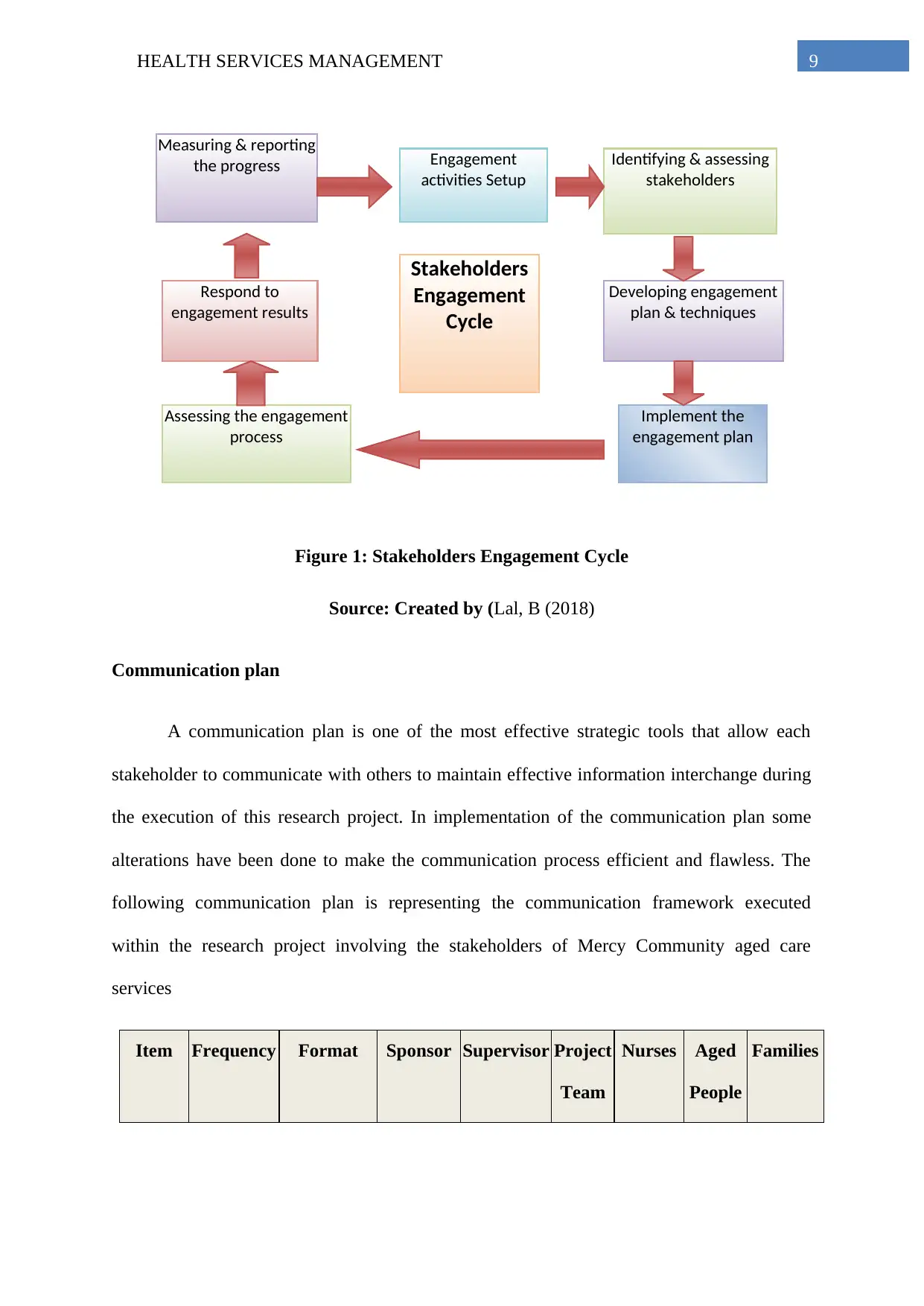
Measuring & reporting
the progress Engagement
activities Setup
Identifying & assessing
stakeholders
Assessing the engagement
process
Respond to
engagement results
Stakeholders
Engagement
Cycle
Implement the
engagement plan
Developing engagement
plan & techniques
9HEALTH SERVICES MANAGEMENT
Figure 1: Stakeholders Engagement Cycle
Source: Created by (Lal, B (2018)
Communication plan
A communication plan is one of the most effective strategic tools that allow each
stakeholder to communicate with others to maintain effective information interchange during
the execution of this research project. In implementation of the communication plan some
alterations have been done to make the communication process efficient and flawless. The
following communication plan is representing the communication framework executed
within the research project involving the stakeholders of Mercy Community aged care
services
Item Frequency Format Sponsor Supervisor Project
Team
Nurses Aged
People
Families
the progress Engagement
activities Setup
Identifying & assessing
stakeholders
Assessing the engagement
process
Respond to
engagement results
Stakeholders
Engagement
Cycle
Implement the
engagement plan
Developing engagement
plan & techniques
9HEALTH SERVICES MANAGEMENT
Figure 1: Stakeholders Engagement Cycle
Source: Created by (Lal, B (2018)
Communication plan
A communication plan is one of the most effective strategic tools that allow each
stakeholder to communicate with others to maintain effective information interchange during
the execution of this research project. In implementation of the communication plan some
alterations have been done to make the communication process efficient and flawless. The
following communication plan is representing the communication framework executed
within the research project involving the stakeholders of Mercy Community aged care
services
Item Frequency Format Sponsor Supervisor Project
Team
Nurses Aged
People
Families
Paraphrase This Document
Need a fresh take? Get an instant paraphrase of this document with our AI Paraphraser
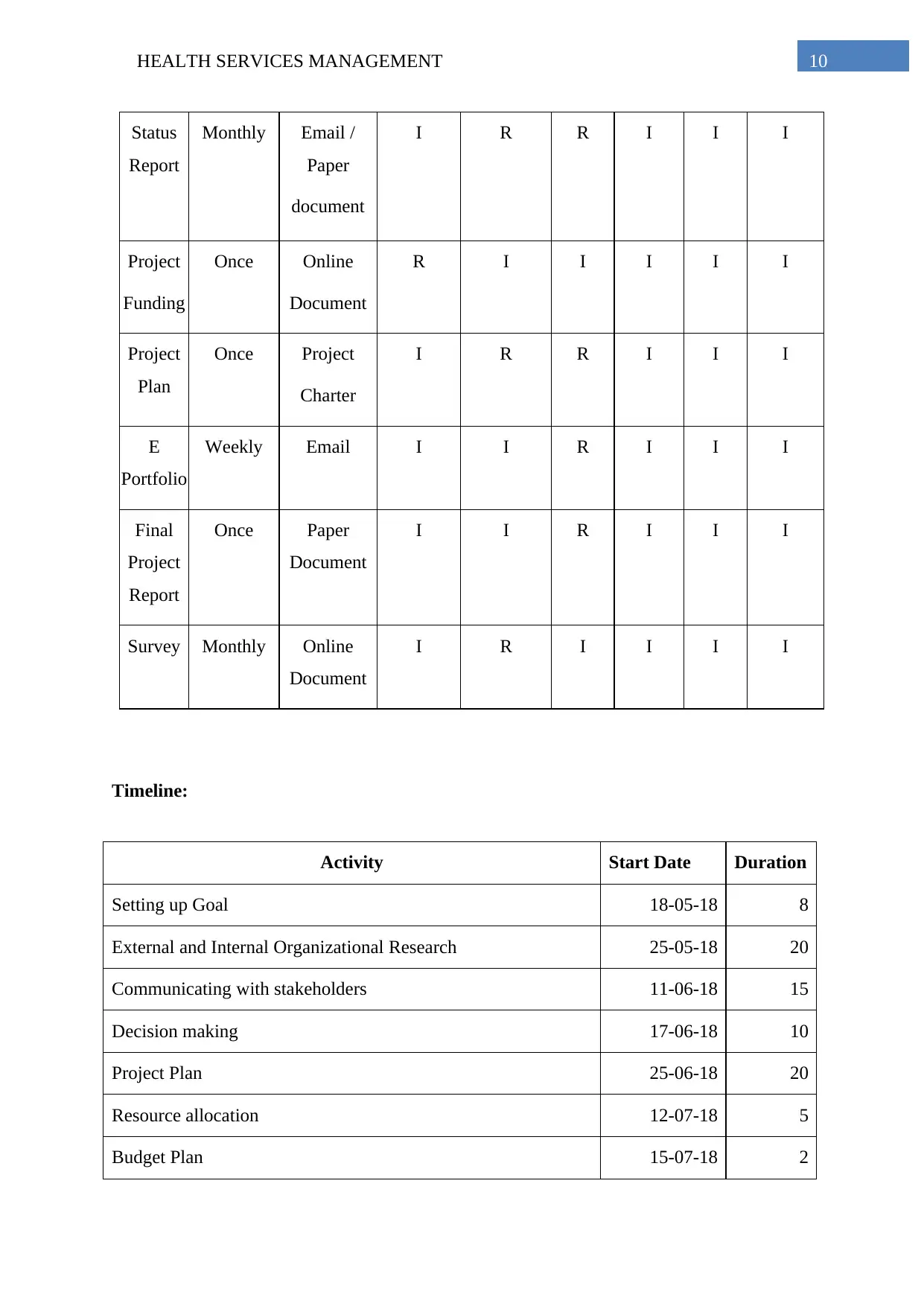
10HEALTH SERVICES MANAGEMENT
Status
Report
Monthly Email /
Paper
document
I R R I I I
Project
Funding
Once Online
Document
R I I I I I
Project
Plan
Once Project
Charter
I R R I I I
E
Portfolio
Weekly Email I I R I I I
Final
Project
Report
Once Paper
Document
I I R I I I
Survey Monthly Online
Document
I R I I I I
Timeline:
Activity Start Date Duration
Setting up Goal 18-05-18 8
External and Internal Organizational Research 25-05-18 20
Communicating with stakeholders 11-06-18 15
Decision making 17-06-18 10
Project Plan 25-06-18 20
Resource allocation 12-07-18 5
Budget Plan 15-07-18 2
Status
Report
Monthly Email /
Paper
document
I R R I I I
Project
Funding
Once Online
Document
R I I I I I
Project
Plan
Once Project
Charter
I R R I I I
E
Portfolio
Weekly Email I I R I I I
Final
Project
Report
Once Paper
Document
I I R I I I
Survey Monthly Online
Document
I R I I I I
Timeline:
Activity Start Date Duration
Setting up Goal 18-05-18 8
External and Internal Organizational Research 25-05-18 20
Communicating with stakeholders 11-06-18 15
Decision making 17-06-18 10
Project Plan 25-06-18 20
Resource allocation 12-07-18 5
Budget Plan 15-07-18 2
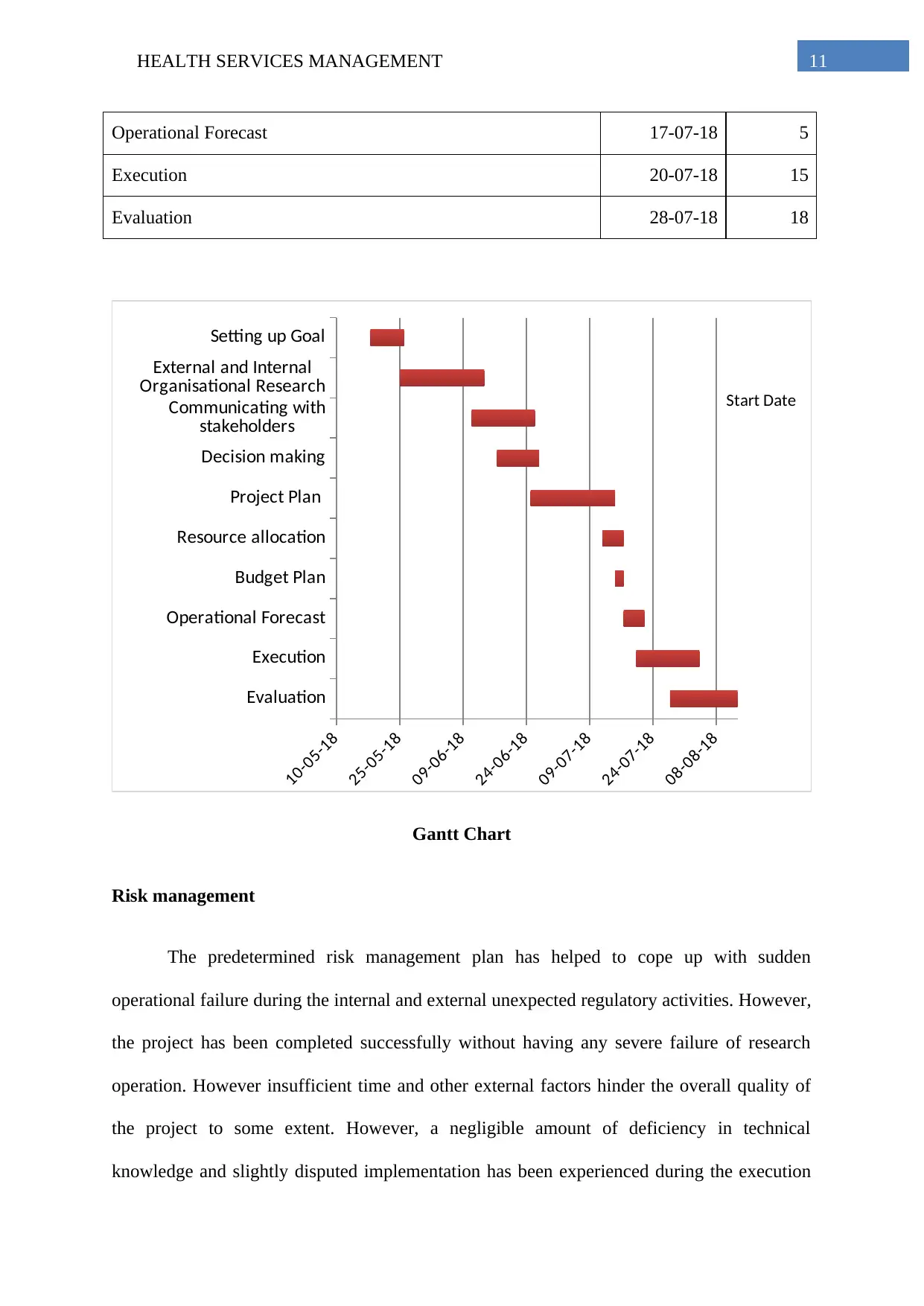
11HEALTH SERVICES MANAGEMENT
Operational Forecast 17-07-18 5
Execution 20-07-18 15
Evaluation 28-07-18 18
Evaluation
Execution
Operational Forecast
Budget Plan
Resource allocation
Project Plan
Decision making
Communicating with
stakeholders
External and Internal
Organisational Research
Setting up Goal
10-05-18
25-05-18
09-06-18
24-06-18
09-07-18
24-07-18
08-08-18
Start Date
Gantt Chart
Risk management
The predetermined risk management plan has helped to cope up with sudden
operational failure during the internal and external unexpected regulatory activities. However,
the project has been completed successfully without having any severe failure of research
operation. However insufficient time and other external factors hinder the overall quality of
the project to some extent. However, a negligible amount of deficiency in technical
knowledge and slightly disputed implementation has been experienced during the execution
Operational Forecast 17-07-18 5
Execution 20-07-18 15
Evaluation 28-07-18 18
Evaluation
Execution
Operational Forecast
Budget Plan
Resource allocation
Project Plan
Decision making
Communicating with
stakeholders
External and Internal
Organisational Research
Setting up Goal
10-05-18
25-05-18
09-06-18
24-06-18
09-07-18
24-07-18
08-08-18
Start Date
Gantt Chart
Risk management
The predetermined risk management plan has helped to cope up with sudden
operational failure during the internal and external unexpected regulatory activities. However,
the project has been completed successfully without having any severe failure of research
operation. However insufficient time and other external factors hinder the overall quality of
the project to some extent. However, a negligible amount of deficiency in technical
knowledge and slightly disputed implementation has been experienced during the execution
⊘ This is a preview!⊘
Do you want full access?
Subscribe today to unlock all pages.

Trusted by 1+ million students worldwide
1 out of 33
Related Documents
Your All-in-One AI-Powered Toolkit for Academic Success.
+13062052269
info@desklib.com
Available 24*7 on WhatsApp / Email
![[object Object]](/_next/static/media/star-bottom.7253800d.svg)
Unlock your academic potential
Copyright © 2020–2025 A2Z Services. All Rights Reserved. Developed and managed by ZUCOL.





